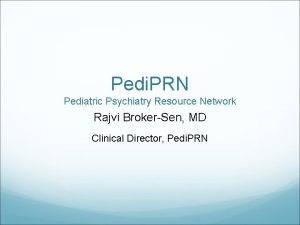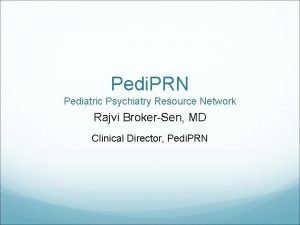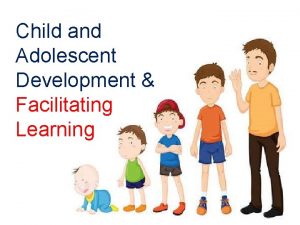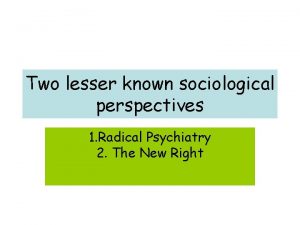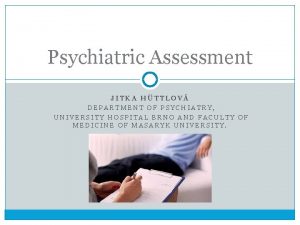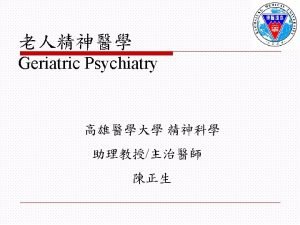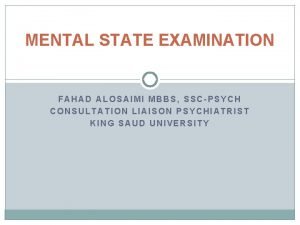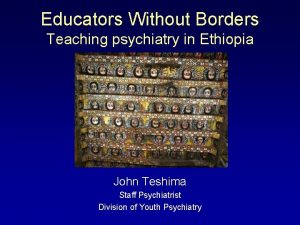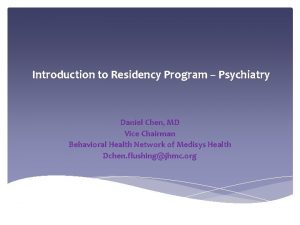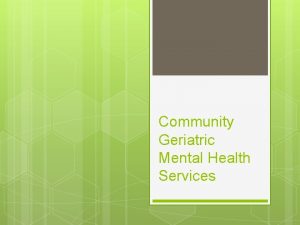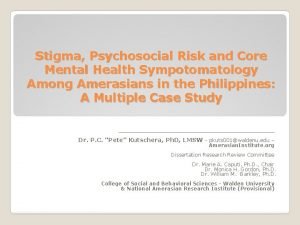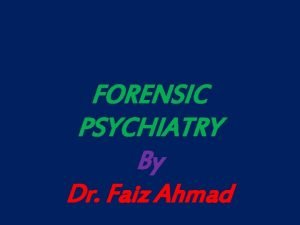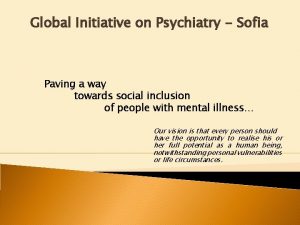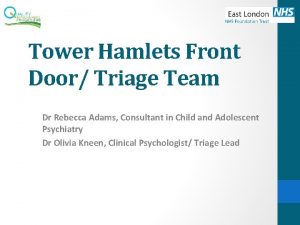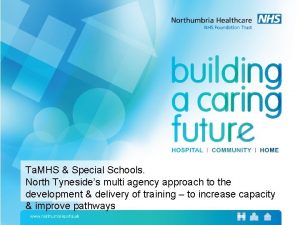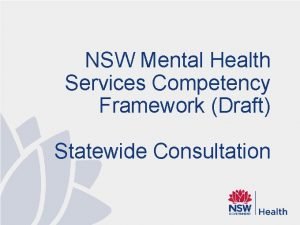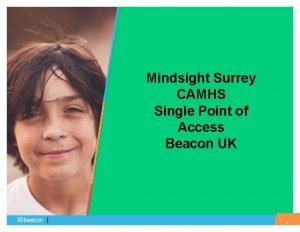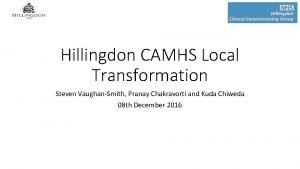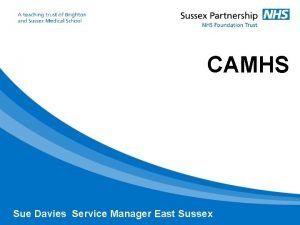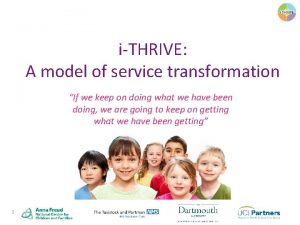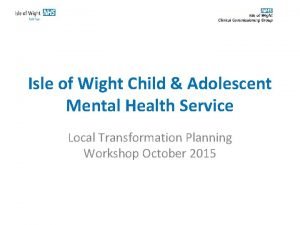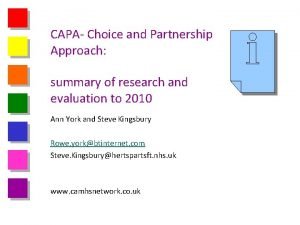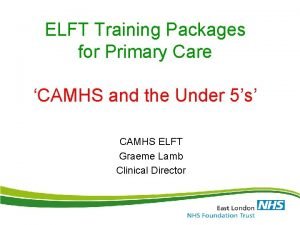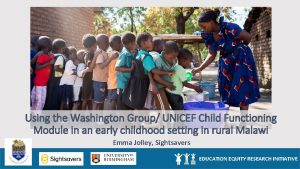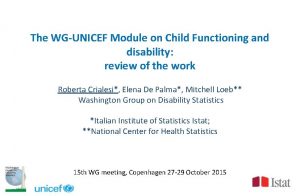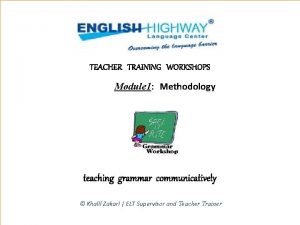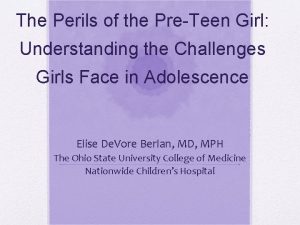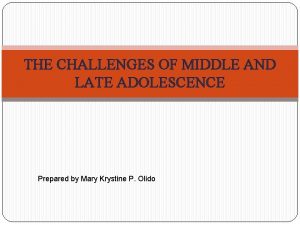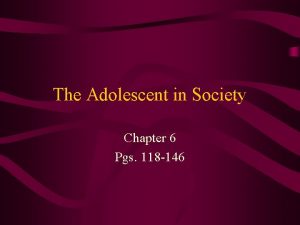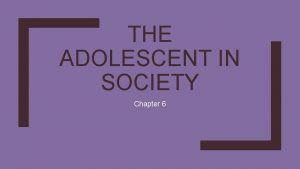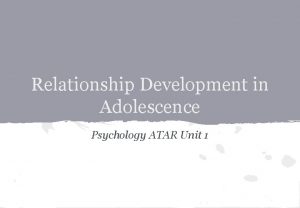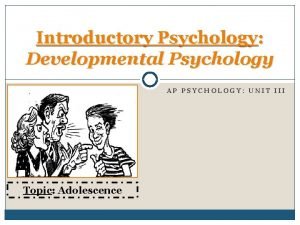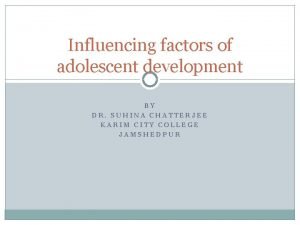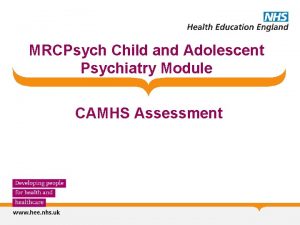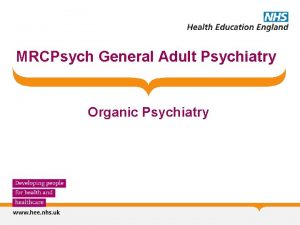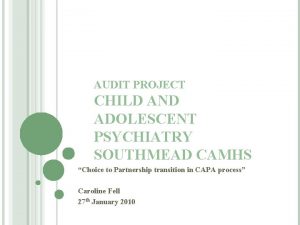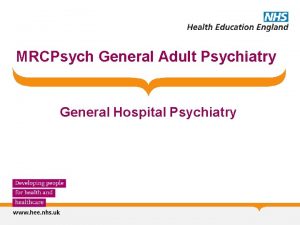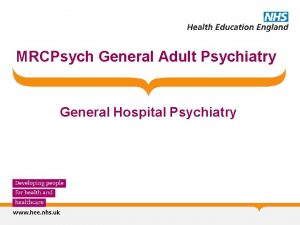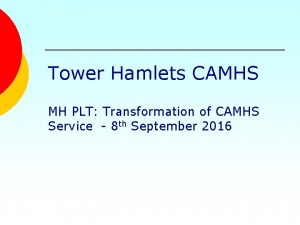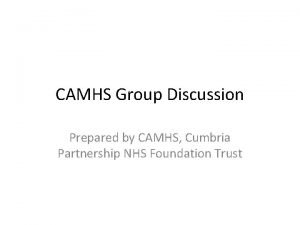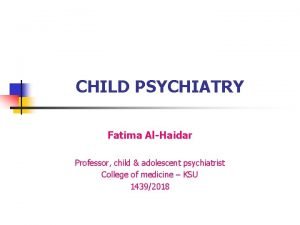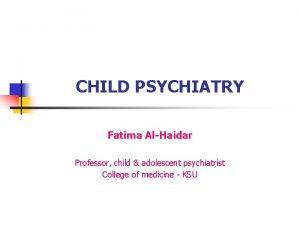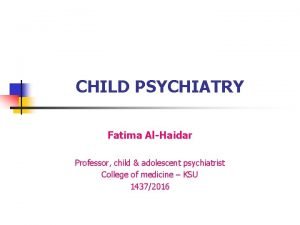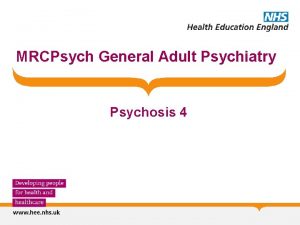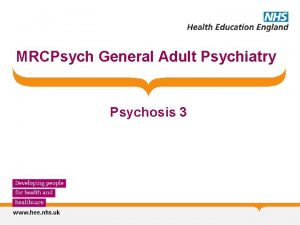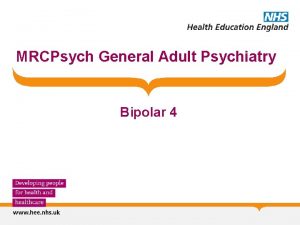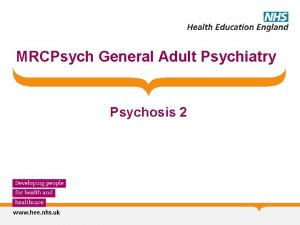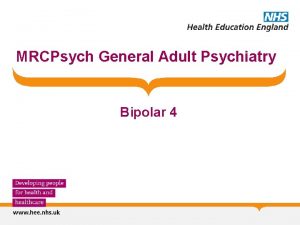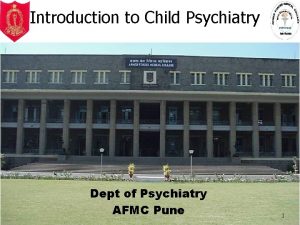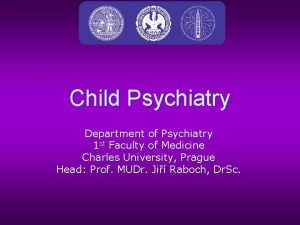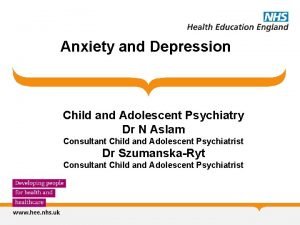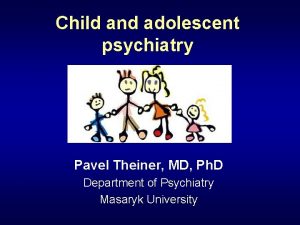MRCPsych Child and Adolescent Psychiatry Module CAMHS Assessment
















































- Slides: 48

MRCPsych Child and Adolescent Psychiatry Module CAMHS Assessment

CAMHS Assessment Aims and Objectives • The overall aim is for the trainee to gain an overview of the assessment in CAHMS • By the end of the session trainees should: – Undertake assessments of children and young people; to communicate effectively with children and young people across the age range; to take a developmental history; to formulate and prepare a plan and identify appropriate interventions. – Describe how the emphasis of assessments in CAMHS may be different to that in Adult Mental Health.

CAMHS Assessment To achieve this • • • Case Presentation Journal Club 555 Presentation Expert-Led Session MCQs • Please sign the register and complete the feedback

CAMHS Module Expert Led Session Assessment in CAMHS Dr Neelo Aslam Consultant Child and Adolescent Psychiatrist CMFT

What Is Child And Adolescent Psychiatry? • Management of emotions and behaviour lying outside the normal range for age and sex and causing distress • Interferes with – emotional development, social relationships and academic progress • Association with adult mental illness • In infancy the child’s temperament and quality of relationship with the main carer is important for mental well being • Later, relationships with family and peers (e. g bullying) and school success - important factors • Early traumatic experiences including – physical illness and developmental delay all increase the risk of childhood psychiatric disorder • A developmental perspective must be taken.

How Do We Work? • The service is delivered in a multidisciplinary style on an out-patient, day-patient or in-patient basis from hospital departments or the community • Important members of the multidisciplinary team include – – – – parents psychiatrists nurses, social workers teachers, clinical psychologists voluntary agencies e. g. NSPCC paediatricians occupational and speech therapists.

Types of disorder • World Health Organisation 10 th Revision of The International Statistical Classification of Diseases (ICD 10) • Chapter V of this international classification system is dedicated specifically to mental and behavioural disorders • Children and adolescents can be affected by disorders more typical of adults e. g. obsessive compulsive disorder, adjustment disorders, depressive episodes, anorexia nervosa, sleep disorders, schizophrenia and substance abuse etc but there are conditions occurring first or only in childhood

Behavioural & Emotional Disorders with Onset Usually Occurring in Childhood & Adolescence • • Hyperkinetic Disorders Conduct disorders Mixed Disorder of Conduct Emotional Disorders with Onset Specific to Childhood – Separation Anxiety , Phobic Anxiety Disorder, Sibling Rivalry Disorder • Disorders of Social Functioning with Onset Specific To Childhood – Elective Mutism, Attachment Disorders • Tic Disorders – Transient Tic Disorder, Tourette’s syndrome • Other Behavioural and Emotional Disorders with Onset Specific to Childhood – Non-organic Enuresis, Non-organic Encopresis, Feeding disorder Pica of infancy

Disorders of Psychological Development • Pervasive Developmental Disorders – Autism Asperger’s Syndrome, Rett’s Syndrome • Specific Developmental Disorders of Speech and Language Specific Developmental Disorders of Scholastic Skills – Specific Reading Disorder, Specific Spelling Disorder • Specific Developmental Disorder of Motor Function

First Interview with Patient & Family • The first interview may take up to l½ hours • It is important to meet with both parents if possible along with the child initially • If assessing an adolescent you may wish to see the adolescent before seeing the parents • A younger child may not wish to separate from their parents at the first interview • The first appointment should help the clinician have an appreciation of: – The presenting difficulties, their severity and impact on the family or wider society e. g. school – What factors may have triggered, exacerbated or maintained the presenting problems – The strengths of the family and child and whether they are motivated to working on the issues – The expectations and ideas that the family have about being seen by CAMHS

History taking • Foundation for a thorough assessment is to take a detailed history • Presenting complaint – Description – Recent examples, focusing on precipitating factors, context and exacerbating and relieving factors. – When did it start? – Frequency – Severity – Change of symptoms over time – What effect does it have? – What help was sought previously? How helpful was this? – What do they put it down to?

Recent behaviour /emotional state • • Being disobedient, destructive, defiant, having tempertantrums, telling lies, fire setting, stealing, taking drugs or alcohol, smoking, solitary or accompanied involvement with the police, cruelty to animals/young children Does this behaviour occur at home or outside How is it dealt with? Happy or miserable, crying often worries Suicidal thoughts Talking about or threatening suicide Acts of self-harm Routines, Rituals, obsessions, fussy or fadd.

Health/Past Medical History • • • Is he/she off school at all? Generally healthy? ROS – – • Asthma, headaches, stomachaches, eyesight, hearing, fainting, fits, absences Childhood infections Immunisations Allergies, drugs, food Eating difficulties – • Food refusal, faddiness, feeding problems Sleeping problems – – • settling, waking, nightmares, sleeping arrangements Tics, mannerisms PMH – Illnesses, operations, hospitalisations

Family History • • • Persons in home – age, religion, occupation, education, current mental/ physical illness, personality, seen by psychiatrist Details of parents own childhood and family support network Family history of psychiatric disorders, psychiatric treatment, enuresis, alcoholism, epilepsy/other illness Domestic conflict or violence/extent of childhood exposure to violence Family life and relationships Parental relationships – how do they get on? How do they spend evenings, weekends? To what extent do they both participate in childcare, discipline etc? Parent-child interaction – closeness, description Child’s participation in family activities – helps at home etc. Rules and routines at home.

Personal History/Developmental History • • • Pregnancy – planned, complications Delivery – spontaneous/induced, place, date, labour, presentation, mode of delivery, gestation, birth weight, complications, resuscitation/SCBU Mother’s health during and after pregnancy - depression Neonatal period – breathing, feeding, convulsions, jaundice, and infections, how long in hospital? Infancy – feeding, weaning, sleep pattern, placid or active, irritable, easy or difficult temperament. Any behavioural difficulties eg tantrums as a toddler

Personal History Milestones sitting unsupported, walking unaided, first word with meaning, first 2 word phrases, and comparison with siblings Bladder and bowel control dry by day and night, bowel control. Separations apart from parents. How child reacted on separation for nursery/toddler playgroup Interactions with peers as a young child

School • Present school – – – – • • happy, progress, and contact with school Attendance Academic strengths & weaknesses. Check with school. Non-academic skills, independence Social relationships, statutory assessment or involvement of Educational Psychologist. Behaviour Support or learning support service Previous schools Relationships – with other adults, with teachers, other children, opposite sex

Social history • Home circumstances – • Other care arrangements – • Child minder, baby sitter Finances – • description of the house, sleeping arrangements, community, overcrowding. any difficulties Neighbourhood – description of area, house moves, community violence, neighbour disputes

Personality/Temperament • Meeting new people – other adults, children, shy, clingy, how quickly does he/she adapt to change? New situations • – • Emotional expression – • introvert, extrovert, generally happy/miserable Affection & Relationships – • how does he/she show feelings, affectionate, confiding, friendships: school, at home Sensitivity – • new places, new tools, explore or hand back. response to person/animal hurt, reaction if told off, did something wrong Interests, hobbies

Interview with Child & MSE • Determined by the child’s age and developmental level • Provide the right materials (crayons, paper, books) and a safe and private environment • Initially, talk about neutral topics or things which the child or adolescent is interested in • It is important that you explain to the child that the interview is confidential and the limits of that confidentiality • With younger children you may wish to encourage the child to play with toys, draw or describe their family, friends or school • Approach discussion of feelings later on • With an adolescent, the interviewer may involve more direct questions and more of a verbal interchange • By the end of the interview you should have a reasonable idea about the child’s understanding of why they are being seen and some idea of their emotional state

Mental state examination • Appearance and behaviour: dress, physical appearance, motor activity, co-ordination, involuntary movements • Language: expression, comprehension, speech – spontaneous, quantity, rate, rhythm, and complexity • Mood: subjective, objective, symptoms/signs of depression, suicidal feelings, anxiety, panic, anger, aggression, and irritability • Abnormal beliefs, experiences, thought content, hallucinations, delusions, worries, fears, preoccupations, obsessions, fantasies or wishes • Social response to interviewer: humour, rapport, eye contact, empathy, and co-operation, shy, confident • Cognition: attention span/distractibility, draw a person (note grip, handedness), write name, give days of week, months of year, counting, simple arithmetic, orientation, memory, general knowledge, reading skills/level of attainment

Other sources of Information • Writing to school with appropriate consent • Undertaking school assessment with appropriate consent • Undertaking home observations

Assessment Tools • ADOS/ADI/DISCO • Psychometrics • Questionnaires – SRS – SDQ – Connors/SNAP IV – SE rating scales

Multiaxial Diagnosis • In child and adolescent psychiatry we use the multiaxial classification to describe in shorthand the problems, which the child is presenting with • The axes are as follows: • Axis I Psychiatric Diagnosis according to ICD 10. • Axis II Specific learning disability • Axis III General learning difficulties • Axis IV Medical diagnosis • Axis VAbnormal psychosocial situations

Formulation • This is a brief description of the child’s presenting problems, any precipitating, predisposing or maintaining factors • It helps to consider the factors under Biological, Psychological & Social categories • FACTORS – BIOLOGICAL – PSYCHOLOGICAL – SOCIAL • PREDISPOSING/PRECIPITATING/MAINTAINING/PROTECT IVE • The formulation is useful in helping to highlight areas for intervention and producing a management plan with a description of the likely prognosis

Risk Assessment • Factors – Historical – what has happened in the past – Clinical – what disorder the child has – Social – deprivation/family/school/drugs – Demographic – gender/age – Developmental – stage/delay

CAMHS Module Any Questions? MCQs on the next slide

CAMHS Module MCQs • Patient should routinely have a neurological examination if they present with all except: A. B. C. D. E. History of an episode of fainting History of seizures Developmental delay Dysmorphic features Abnormal gait

CAMHS Module MCQs • Patient should routinely have a neurological examination if they present with all except: A. B. C. D. E. History of an episode of fainting History of seizures Developmental delay Dysmorphic features Abnormal gait

CAMHS Module MCQs • A physical risk assessment for patients with Anorexia Nervosa should include all except: A. B. C. D. E. Assessment of BMI and weight Assessment of heart rate Assessment of temperature Assessment of hydration status Assessment of EEG abnormalities

CAMHS Module MCQs • A physical risk assessment for patients with Anorexia Nervosa should include all except: A. B. C. D. E. Assessment of BMI and weight Assessment of heart rate Assessment of temperature Assessment of hydration status Assessment of EEG abnormalities

CAMHS Module MCQs • During an assessment of a 14 year old patient with depression in primary care, which of the following would prompt you to refer to tier 2 or 3 CAMHS: A. Mild depression in those who have not responded to interventions in tier 1 after 2 -3 months B. Active suicidal plans C. Referral requested by the young person D. Moderate to severe depression E. All of the above

CAMHS Module MCQs • During an assessment of a 14 year old patient with depression in primary care, which of the following would prompt you to refer to tier 2 or 3 CAMHS: A. Mild depression in those who have not responded to interventions in tier 1 after 2 -3 months B. Active suicidal plans C. Referral requested by the young person D. Moderate to severe depression E. All of the above

CAMHS Module MCQs • Assessment of ADHD commonly include all except: A. B. C. D. E. ADOS School observations History from parents/carers Connors assessment History from patient

CAMHS Module MCQs • Assessment of ADHD commonly include all except: A. B. C. D. E. ADOS School observations History from parents/carers Connors assessment History from patient

CAMHS Module MCQs • Mental state examination of a 15 year old patient should include all the following except: A. B. C. D. E. Assessment of appearance and behaviour Family history Assessment of speech Assessment of insight Assessment of cognition

CAMHS Module MCQs • Mental state examination of a 15 year old patient should include all the following except: A. B. C. D. E. Assessment of appearance and behaviour Family history Assessment of speech Assessment of insight Assessment of cognition

CAMHS Module MCQs • The multi axial diagnostic formulation scheme of ICD 10 include: A. B. C. D. E. Axis III: psychiatric disorder Axis II: medical conditions Axis IV: adaptive functioning Axis I: psychiatric disorder Axis VI: medical conditions

CAMHS Module MCQs • The multi axial diagnostic formulation scheme of ICD 10 include: A. B. C. D. E. Axis III: psychiatric disorder Axis II: medical conditions Axis IV: adaptive functioning Axis I: psychiatric disorder Axis VI: medical conditions

CAMHS Module MCQs • An assessment of a 3 year old with suspected Autistic Spectrum Disorder must include: A. B. C. D. E. A home visit A detailed mental state examination Observation of the child interacting with others All of the above A-C None of the above A-C

CAMHS Module MCQs • An assessment of a 3 year old with suspected Autistic Spectrum Disorder must include: A. B. C. D. E. A home visit A detailed mental state examination Observation of the child interacting with others All of the above A-C None of the above A-C

CAMHS Module MCQs • CAMHS assessments in patients with speech delay should routinely include all except: A. B. C. D. E. Family tree Family history of ASD/Aspergers Developmental history Details of whether the patient had the combined MMR vaccine Medical history

CAMHS Module MCQs • CAMHS assessments in patients with speech delay should routinely include all except: A. B. C. D. Family tree Family history of ASD/Aspergers Developmental history Details of whether the patient had the combined MMR vaccine E. Medical history

CAMHS Module MCQs • The presence of a disorder can be explained in terms of all except: A. B. C. D. E. Predisposing factors Precipitating factors Perpetuating factors Petulant factors Protective factors

CAMHS Module MCQs • The presence of a disorder can be explained in terms of all except: A. B. C. D. E. Predisposing factors Precipitating factors Perpetuating factors Petulant factors Protective factors

CAMHS Module MCQs • In regards to initial CAMHS assessment of children under 5 with speech delay: A. You should not see them without the presence of their parent/carer in the room B. You should aim to get the child sat down in a chair for the majority of the assessment C. You should observe them playing and play too if appropriate D. You should avoid difficult topics E. You should use more directed questioning

CAMHS Module MCQs • In regards to initial CAMHS assessment of children under 5 with speech delay: A. You should not see them without the presence of their parent/carer in the room B. You should aim to get the child sat down in a chair for the majority of the assessment C. You should observe them playing and play too if appropriate D. You should avoid difficult topics E. You should use more directed questioning

CAMHS Module Any Questions? Thank you
 Pediprn
Pediprn National network of child psychiatry access programs
National network of child psychiatry access programs Scaffold and fade-away technique
Scaffold and fade-away technique Discontinuity of development
Discontinuity of development Radical psychiatry sociology
Radical psychiatry sociology Mse psych
Mse psych Geriatric psychiatry definition
Geriatric psychiatry definition Forensic psychiatry vs forensic psychology
Forensic psychiatry vs forensic psychology Abstract thinking examples
Abstract thinking examples Pediatrics shelf exam percentiles
Pediatrics shelf exam percentiles Cécile hanon
Cécile hanon Psychiatry in ethiopia
Psychiatry in ethiopia Daniel chen md
Daniel chen md What is criminal psychology definition
What is criminal psychology definition Addiction expert witnesses
Addiction expert witnesses Community geriatric psychiatry
Community geriatric psychiatry Core psychiatry
Core psychiatry Asclepiades father of psychiatry
Asclepiades father of psychiatry Dr faiz ahmad
Dr faiz ahmad Gipsofia
Gipsofia Camhs wirral
Camhs wirral Doors tower hamlets
Doors tower hamlets Special schools north tyneside
Special schools north tyneside Camhs competency framework
Camhs competency framework Mindsight surrey camhs
Mindsight surrey camhs Camhs hillingdon
Camhs hillingdon Camhs darlington
Camhs darlington Camhs hailsham
Camhs hailsham Ithrive model
Ithrive model Camhs isle of wight
Camhs isle of wight 03002225755
03002225755 Choice and partnership approach website
Choice and partnership approach website Wirral camhs
Wirral camhs Elft camhs
Elft camhs Camhs camden
Camhs camden C device module module 1
C device module module 1 What is child functioning module
What is child functioning module What is child functioning module
What is child functioning module Communicative grammar
Communicative grammar 이진트리 복사 순회
이진트리 복사 순회 Pre adolescent girl
Pre adolescent girl Challenge of middle and late adolescence
Challenge of middle and late adolescence Chapter 6 the adolescent in society
Chapter 6 the adolescent in society Developmental tasks for adolescent
Developmental tasks for adolescent The adolescent in society guided reading
The adolescent in society guided reading Dunphy's 5 stages
Dunphy's 5 stages Developmental psychology
Developmental psychology Factors that influence adolescent development?
Factors that influence adolescent development? Ego strength erikson
Ego strength erikson
